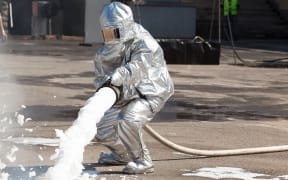A United States expert is warning that New Zealand's acceptable levels for drinking water contamination from toxic firefighting foam chemicals are way too high.

Photo: 123RF
The warning comes after the Environmental Protection Authority [EPA] launched an investigation into where the foam - which was banned in 2006 - might still be used and stored.
The investigation is focused on airports, and "other locations" but hasn't revealed where they are.
Auckland Airport told RNZ last week it is still using PFOA foam but the EPA has refused to comment on that.
Drinking water tests took place, and cleared, Blenheim's town supply only last week, despite the Defence Force knowing since 2015 that the groundwater at Ohakea and Woodbourne was contaminated.
Professor Dick Clapp, who is based in Boston, and has researched the emerging health risks of foam contaminants said that if it is found in groundwater, it could have an effect on the drinking water at some point.
"So the prevention of exposure is to keep testing the drinking water," he said.
New Zealand authorities have so far refused to release the test results to show how far above acceptable levels the groundwater contamination is.
The contaminants - named PFOS and PFOA - have triggered global health alerts that have multiplied rapidly since 2000, and which New Zealand has been aware of since at least 2004.
New Zealand's upper level for PFOS, adopted as an advisory guideline only in April, at 70 parts per trillion in drinking water, is the same as the US federal guideline.
But this country's PFOA upper level of 560ppt is eight times higher than the federal level, and 112 times higher than what Michigan is poised to introduce.
"PFOA has been more thoroughly studied and it is perhaps more worrisome than PFOS," Professor Clapp said.
"The mechanism of action in the body is similar enough that they are both equally dangerous."
His co-researcher Philippe Grandjean is proposing a safe level of just one part per trillion, after his studies in the Faroe Islands showed that above this level the chemicals undermined vaccine actions in children.
His studies of children born with higher levels of perfluorinated compounds had diminished immune systems by age 6.
Professor Clapp says research on the children is ongoing to determine if there are any adverse health effects by age 13.
He said he expected that within five years both PFOS and PFOA would be classified as cancer causing.
In New Zealand, the firefighting foam chemicals - last used by Defence in 2002 and the Fire Service in 2006 - had so far flown under the radar, said Water NZ technical manager Noel Roberts.
"Currently they're not in the drinking water standards at all, so water suppliers - it won't be on their radar."
The firefighting issue comes on the heels of the Havelock North water contamination inquiry which slated the Health Ministry's regulation of water as inept.
It had not changed drinking water standards in 10 years, during which time technology and understanding of contamination had changed a lot, said Mr Roberts.
But unless the Havelock North inquiry recommendation to set up a well-resourced, independent regulator was followed through, the Ministry faced a big task with few resources to address the firefighting foam issue, he said.
The Institute of Environmental Science and Research told the Environment Ministry last year there was the opportunity for a broad study into PFOS and PFOA distribution in New Zealand, to back up earlier Massey University studies which showed an encouraging drop in people's exposure to this class of chemicals.
That study has not happened.



